Exploring November's Birthstones: Topaz and Citrine
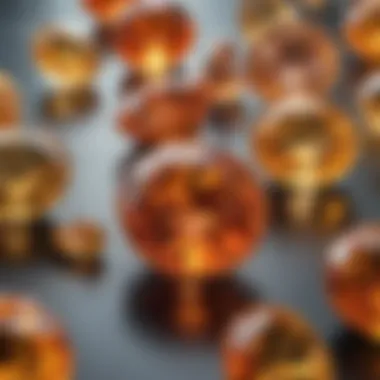

Intro
November holds a special place in the world of gemstones, with two captivating birthstones: topaz and citrine. Each of these gemstones, vibrant in their hues and rich in history, offers a unique lens through which we can examine not only their physical properties but also their cultural and metaphysical significance. As we embark on this journey, we will unravel the stories that these gems carry—stories woven into the fabric of ancient civilizations and modern-day beliefs.
Why should the colors of topaz and citrine matter to you? These stones are not just pretty trinkets; they resonate with deeper meanings and energies that have captured the hearts of many. Understanding their essence can enrich your appreciation and guide your choices whether you're a collector, a jewelry designer, or simply someone observing their beauty.
Gemstone Overview
Definition and Characteristics
Topaz and citrine, though often confused due to their similar appearances, possess distinct characteristics that set them apart. Topaz is known for its remarkable clarity and brilliance, often appearing in hues ranging from golden yellow to deep amber. It can also showcase shades of blue, pink, or colorless varieties, making it a highly versatile option in jewelry.
Citrine, on the other hand, is celebrated for its warm, sunny yellows and golden browns. This gemstone is a variety of quartz and stands out due to its affordability and the sunny glow it exudes.
Both topaz and citrine are sought after not just for their stunning aesthetics, but also for a variety of applications in holistic practices, where they are believed to possess various healing properties.
Classification of Gemstones
When discussing topaz and citrine, it's essential to classify them within the broader context of gemstones. They both fall under the category of silicate minerals, yet they differ in their composition. Topaz is a fluoride-aluminosilicate mineral while citrine is a quality of quartz composed primarily of silicon dioxide.
"Gemstones tell stories not just with their colors, but through the chemistry etched into their very structure."
Properties of Gemstones
Physical Properties
The physical properties of these gemstones largely contribute to their appeal and usability. Topaz scores an impressive 8 on the Mohs scale of hardness, making it a durable option for daily wear. It exhibits perfect cleavage, allowing it to be cut into a variety of shapes and designs.
Citrine, while slightly softer at 7 on the Mohs scale, still holds up well in jewelry. Its transparent quality and ability to reflect light grant it an alluring sparkle that can brighten up any piece.
Chemical Properties
In terms of chemical properties, the difference becomes glaringly evident. Topaz's composition includes aluminum and fluorine, contributing to its resistances against wear and scratching. Citrine's mainly consists of silicon and oxygen, which imbue it with its unique yellowish tint due to the presence of iron.
Understanding these underlying chemical properties gives insight not only into the durability and care of the stones but also opens the door to their potential uses in practices such as crystal healing and meditation.
In summary, the exploration of topaz and citrine reveals a fascinating duality within November's birthstones—a mix of beauty and strength rooted in rich tradition. Each gemstone is much more than a simple ornament; they carry with them a depth of meaning that is well worth uncovering.
Prelims to November Birthstones
November births are graced with two vibrant gemstones, topaz and citrine. Each stone carries a depth of history, unique hues, and intriguing meanings that echo through generations. Understanding the significance of these birthstones not only fosters a connection to personal identity but also enhances appreciation for the traditions woven around them. Birthstones can act as talismans, believed to influence the bearer’s fate, lending them emotional or even physical benefits.
The Concept of Birthstones
The idea of birthstones is anchored in ancient lore, originating from the twelve stones listed in the Book of Exodus, each linked to a zodiac sign or a specific month. These stones weren’t merely decorative; they were thought to offer protection, bring good fortune, and act as markers of personal identity. Wearing your birthstone is akin to donning a piece of history, a sentiment that many find comforting.
- Birthstones can connect individuals to their cultural and spiritual heritage.
- They often serve as gifts reflecting thoughtful intentions and consideration.
- Many believe they enhance specific qualities or advantages, infusing the wearer with certain energies.
Overview of November's Birthstones
November proudly showcases two birthstones: topaz and citrine. Topaz, often recognized for its stunning blue hues, can also appear in golden, red, or clear variations. Citrine, known for its warm, amber glow, symbolizes joy and prosperity. The interplay of these stones combines to create a rich narrative.
- Topaz: Known for its versatility, this stone takes on shades ranging from crystal-clear to deep golden hues. Historically, it has been thought to promote wisdom and relaxation.
- Citrine: This bright, sunny stone is deeply associated with vitality and energy, often thought to attract wealth and positivity to its bearer.
The stories behind these stones enhance their allure. Understandably, people born in November may feel a unique connection to their birthstones. It's more than a piece of jewelry; it's a representation of their character and life journey.
"The stones we choose are reflections of who we are and what we aspire to be."
In summary, by diving into the world of November's birthstones, we uncover layers of cultural significance and personal identity. This exploration not only enriches our understanding but also ignites an appreciation for the intricate connections that bind us to these gems.
Exploring Topaz
Topaz, a captivating gemstone widely recognized for its stunning array of colors, plays a pivotal role in the pantheon of November birthstones. Its versatility captures the imagination of jewelers, collectors, and enthusiasts alike. Topaz, not just a pretty face, carries tales of history, symbolism, and metaphysical significance that make it so much more than an ornamental stone. When we delve into its various hues and cultural meanings, it becomes clear that topaz is both a gem and a narrative, intricately woven into the lives of those born in November.
Color Variations of Topaz
Natural Color Range
The natural color range of topaz is nothing short of magnificent. Found in shades like golden yellow, pale blue, and even colorless variations, it showcases a spectrum that appeals to many. The key characteristic of this color range is its authenticity. Natural topaz is formed deep within the Earth, creating colors that are unique and reflective of its geological origins. This authenticity is a strong selling point for both buyers and jewelers—people are drawn to the idea of possessing something truly natural, not mass-produced.
However, it does come with its unique features: the varying quality of natural stones can significantly affect their value. Some people may find the subtler tones of natural topaz to be less striking compared to the vibrancy of altered or synthetic options a preference different folks have.
Synthetic Topaz Colors
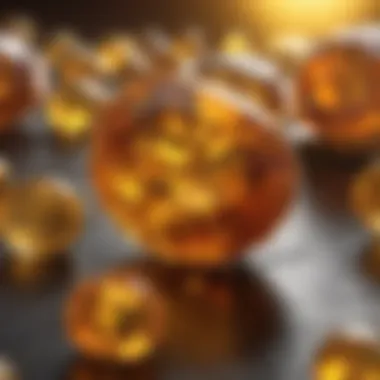
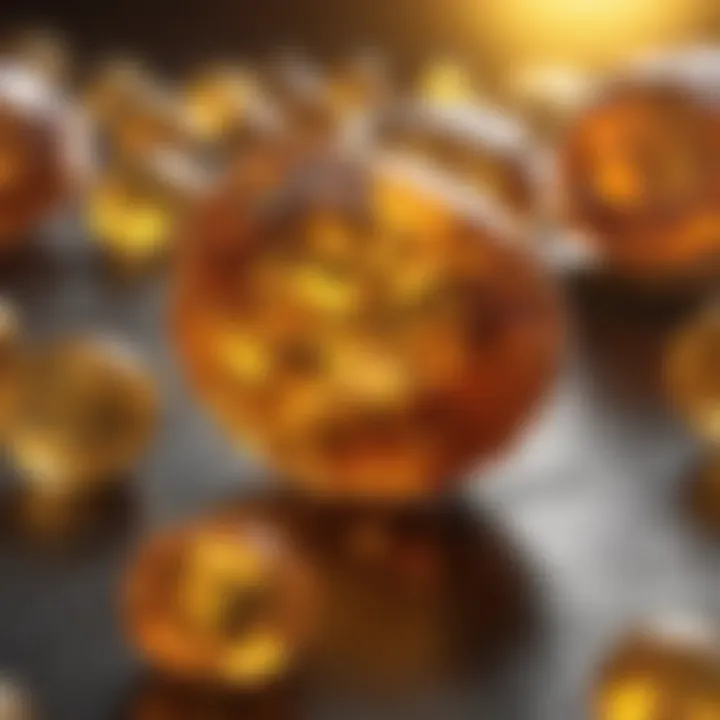
Now let’s shift gears and talk about synthetic topaz colors. While some purists may raise an eyebrow at the idea of synthetic stones, they offer a fascinating alternative. The key characteristic of synthetic topaz is its vibrant colors—think bright pinks and vivid blues that catch the eye immediately. These hues are sometimes harder to find in nature. For those looking for a specific color in their jewelry, synthetic options offer an accessible route to vibrant elegance without breaking the bank.
Yet, the unique feature here is that these synthetics can sometimes lack the depth of character found in natural stones. While they sparkle like stars, they might not carry the same emotional weight, which can matter to some collectors.
The Role of Treatments in Color Enhancement
The role of treatments in color enhancement of topaz cannot be overstated. Heat treatment and irradiation can transform a drab stone into a dazzling display of vivid color. This aspect is appealing for those who want the beauty of topaz but on a budget. Such treatments can elevate the gem from a simple accessory to a striking centerpiece.
The key characteristic to consider here is that treated stones are often more affordable, making beautiful jewelry attainable for more people. However, disclosure of treatments is crucial. Enthusiasts and collectors alike need to know if they’re getting a natural gem or one that’s been enhanced. Thus, the unique feature about this enhancement process is that it opens up avenues for affordability while also creating potential issues regarding authenticity and market value.
Cultural Significance of Topaz
Historical Uses in Jewelry
Digging into the historical uses of topaz in jewelry brings forth a fascinating tapestry. Dating back to ancient civilizations, this gem has adorned crowns and thrones, believed to possess protective qualities. The key characteristic of its historical significance lies in its perceived power—royalty often wore it to ward off bad spirits and promote wisdom. This enduring legacy makes topaz a particularly compelling choice for modern jewelry designers looking to infuse their creations with meaning.
The unique feature is that jewelry made with topaz can be both a style statement and a keeper of ancient wisdom. Yet, not all historical contexts are equal, as newer trends push the boundaries of what is considered fashionable versus traditional.
Symbolism Across Cultures
Topaz holds a multitude of meanings across various cultures. For some, it symbolizes love and affection, while for others, it serves as a talisman for good fortune. The key characteristic here is its ability to transcend geographical boundaries, adapting meanings based on cultural contexts. This allows it to appeal to a very broad audience.
Interestingly, this cultural adaptability could be seen as a unique feature of topaz; it means that its significance can vary widely from one person to another, reflecting their own beliefs and values. However, this can also lead to confusion about its true essence and symbolism, especially for newcomers to the gemstone world.
Topaz in Modern Context
In the modern context, topaz has resurged as a fashionable gemstone. It’s not just coveted for its beauty but also appreciated for its diverse properties. The key characteristic in today’s market is the fusion of tradition and modernity; jewelers are creatively crafting pieces that celebrate both the ancient lore and contemporary trends.
One unique feature of modern topaz use is its incorporation into both high-end jewelry and everyday pieces. This versatility allows it to appeal to a wider audience, from affluent collectors to casual buyers. However, it places a burden on authenticity as many designs may prioritize style over genuine materials.
Metaphysical Properties of Topaz
Healing Attributes
Topaz is often touted for its healing properties, believed to strengthen the body's systems and improve health. Its key characteristic is linked to emotional stability, often associated with clarity and focused energy. This makes it a popular stone among those interested in holistic practices, further enriching its appeal.
When talking about healing attributes, a unique feature is that many users feel more centered and calm while wearing or meditating with topaz. Still, it is essential to note that its efficacy may vary from person to person, leading to debates within communities surrounding its actual benefits.
Emotional and Spiritual Benefits
Moving on to the emotional and spiritual benefits, many people regard topaz as a stone that promotes truth and forgiveness. The key characteristic is that many users report enhanced communication and understanding when they engage with this stone. This aspect makes it particularly enticing for those on personal growth journeys.
However, the unique feature here is also its subjective experience. What works wonders for one may not resonate at all with another, highlighting that personal connection is vital in the metaphysical realm.
Topaz in Meditation Practices
In meditation practices, topaz is often employed to foster a deeper state of introspection. Its key characteristic is the stone’s reputation for promoting mental clarity, making it an excellent companion for meditation sessions. Using topaz during meditative practices can help calms the mind and open up new paths of insight and creativity.
The unique feature of incorporating topaz in meditation is that it provides a tactile element, a physical connection to the energy one is seeking to harness or explore. However, some might argue that relying too much on external objects can detract from inner focus and self-awareness.
"Topaz, whether natural or treated, carries with it the wisdom of history, culture, and personal significance. Understanding its depth improves the experience of owning this vibrant November birthstone."
In summary, exploring topaz unveils a rich history and a vast range of possibilities, making it a favorite among collectors, designers, and gemstone lovers alike. Its multifaceted nature, from color variations to cultural significance, offers both aesthetic appeal and deeper meanings, inviting both new and seasoned enthusiasts to engage with it at multiple levels.
The Allure of Citrine
Citrine, with its warm hues ranging from pale yellow to deep amber, is more than just a beautiful gemstone; it embodies a sense of joy and positivity that resonates with many. In the context of November's birthstones, it plays a crucial role in not only enhancing personal style but also in connecting individuals to a rich history and a plethora of meanings. Citrine is often perceived as a stone of abundance, attracting prosperity and encouraging feelings of warmth. Given this backdrop, it invites both admiration and introspection.
Color Spectrum of Citrine
Natural vs. Heat-Treated Citrine
Natural citrine is a gem that forms from the quartz family, typically displaying a sunny yellow or golden-brown hue. It's a stone that symbolizes cheerfulness and warmth, making it a desirable choice for many jewelers and wearers alike. On the other hand, heat-treated citrine—commonly developed from amethyst or smoky quartz—often displays a richer, more intense yellow or orange tone.
Key characteristic: The fact that natural citrine is rarer than heated variants, which contributes to its desirability, especially among purists and collectors. A unique feature of natural citrine is its ability to retain its warm tones without the aid of artificial enhancements. This authenticity can resonate with gemstone enthusiasts who value nature’s untainted beauty, making it more appealing despite potentially higher costs.
Color Saturation and Quality Factors
The saturation of color in citrine plays a significant role in determining its value and overall appeal. Higher saturation levels generally indicate a deeper richness in hue, making these stones more engaging and eye-catching. Factors influencing this saturation include the stone's origin, as well as any treatments it may have undergone.
One of the prominent aspects worth noting is the clarity of a citrine stone; stones that are free of inclusions are often deemed more valuable and desirable. Additionally, deeper colors can sometimes create a more luxurious impression. However, it’s essential to balance color saturation with transparency; overly deep colors may obscure internal features that could enhance a stone’s beauty.
Citrine's Variability in Shades
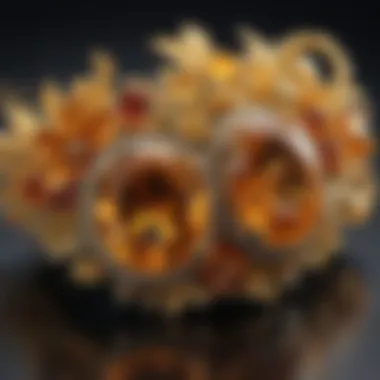
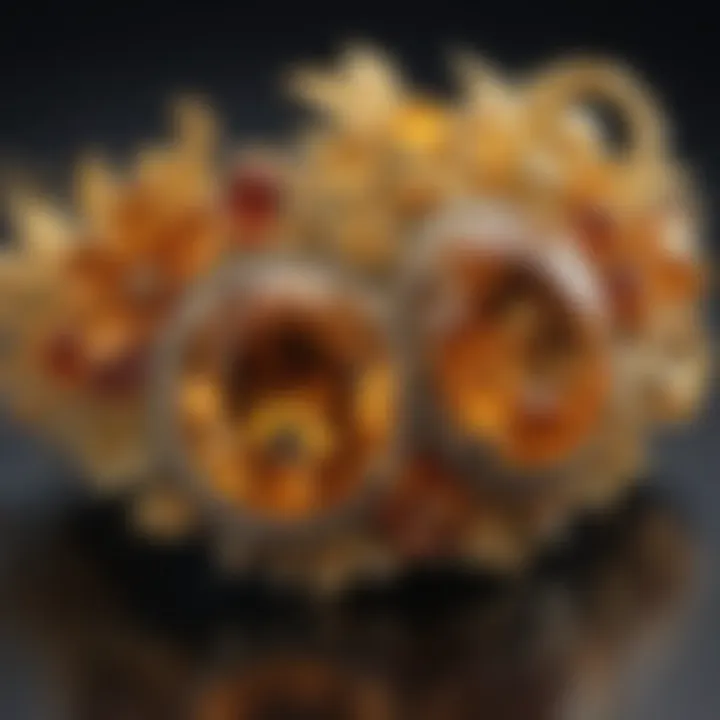
Citrine is known for its remarkable variability in shades, ranging from a pale lemon yellow to a deeper, almost brownish-orange. This flexibility makes it a popular choice among jewelry designers who seek to create a variety of looks. Whether one is drawn to the soft, subtle tones or the vibrant, fiery hues, citrine offers a spectrum that can complement any style.
What makes this variability both a boon and a bane is how it can cater to a diverse audience. Some might find the lighter shades symbolize clarity and new beginnings, while others may see richness and abundance in the darker tones. The possibility to select from various shades means citrine can resonate with multiple personal styles—truly a versatile option for November.
Historical Context of Citrine
Uses in Ancient Civilizations
Citrine has a long-standing history that stretches back to ancient civilizations. Often referred to as the "merchant’s stone" in ancient trading cultures due to its yellow color, many believed it would protect against theft and bring wealth and prosperity. In times of old, other civilizations, like the Greeks and Romans, utilized citrine in jewelry for its aesthetics and purported magical properties.
The significance of its historical use is notable because it laid the groundwork for modern interpretations of citrine as a stone associated with abundance and confidence. Citrine’s valued traits in ancient cultures reflect a continuity of meanings that persist today, making it not just a beautiful stone but a culturally rich one as well.
Citrine in Victorian Jewelry
During the Victorian era, citrine's popularity soared, prized for its exquisite luster and radiant color. It was often incorporated into intricate gold designs, complementing royal and aristocratic fashions of the time. The Victorian love for symbolism extended to jewelry, and citrine, representing joy and light, fit perfectly within the era's opulent aesthetic.
Observing citrine in this historical context allows one to appreciate its evolution from common ornamental stone to a favored gem among the elite. This historical trajectory emphasizes citrine's long-standing allure and enduring appeal.
Modern Day Applications
In the contemporary market, citrine continues to shine, transforming into a staple in everyday jewelry. Designers craft everything from simple rings to elaborate statement pieces using citrine, often pairing it with other gems for eye-catching contrasts. The understanding of its metaphysical properties has also sparked an increased interest, as many believe it can promote positivity and clear thinking.
The adaptability of this stone in modern applications speaks volumes about its relevance. Whether someone is seeking something classic or trendy, citrine fits the bill, allowing wearers to express their individuality while tapping into its historical and metaphysical significance.
Metaphysical Properties of Citrine
Citrine as a Stone of Abundance
Citrine holds a prestigious place in the metaphysical realm and is often dubbed the “stone of abundance.” It is believed to manifest success, prosperity, and wealth by attracting abundance into the user’s life. This reputation dates back centuries, and many people resonate with the idea of holding a piece of this vibrant stone during crucial financial decisions.
One unique advantage of this property lies in its uplifting energy, making it a popular choice among individuals seeking motivation and positivity in pursuit of their goals. However, it’s important to note that while it may assist in attracting abundance, it also encourages hard work and focus, reminding users that success is not merely a product of luck.
Emotional Healing Qualities
Citrine is renowned for its emotional healing qualities. Often utilized in therapies, it is believed to help alleviate feelings of sorrow and replace them with positivity and vitality. Some practitioners advocate for citrine’s inclusion in meditation practices to enhance one’s mood and provide clarity, which can be particularly beneficial during challenging times.
This characteristic of emotional healing offers a dual benefit; not only does it augment one’s mental health, but it also creates an intrinsic connection to the stone, making it an intuitive choice for those feeling drained or uninspired.
Citrine in Energy Work
In energy work, citrine is cherished for its ability to lift vibrations and foster creativity. It is often associated with the solar plexus chakra, believed to connect with personal power and self-confidence. Users typically place citrine in workspaces or wear it during creative endeavors, hoping to stimulate ingenuity.
Its vibrant energy serves as a reminder that creativity is not just an isolated occurrence but rather a flowing part of the universe that can be tapped into. However, while it energizes and uplifts, individuals should also be aware of balancing its effects with grounding stones to avoid overstimulation.
In summary, the allure of citrine transcends mere beauty, encapsulating a world of historical significance, emotional healing, and vibrant color. For those born in November, selecting citrine as their birthstone is akin to embracing a tangible connection to both the past and present, all while enhancing their own personal narratives.
Comparing Topaz and Citrine
When delving into the world of November birthstones, it becomes crucial to understand the differences and similarities between topaz and citrine. Each stone holds its own distinct characteristics, which cater to varying preferences and needs among gemstone enthusiasts, collectors, and jewelry designers. This comparison not only enhances the appreciation of these stones but also guides buyers in their choices, ensuring they select the right birthstone that resonates with their aesthetics and values.
Physical Differences
Hardness and Durability
The hardness and durability of a gemstone play an important role in its appeal for jewelry wearers. Topaz ranks an impressive 8 on the Mohs scale, making it one of the harder gems available. This elevated hardness provides topaz with durability that is ideal for everyday wear, reducing the chances of scratching and damage. In contrast, citrine sits lower on the scale at about 7, which means it can be more susceptible to scratches or chips in daily use. For individuals craving functionality alongside beauty, topaz becomes an obvious choice due to its resilience.
Citrine's vulnerability isn't wholly negative, however. Many enjoy its aesthetic charm for more delicate jewelry pieces. Understanding these nuances allows potential owners to make informed decisions about how and where they wish to display their stones.
Crystal Structure
When one discusses crystal structures, both topaz and citrine feature distinct formations that contribute to their beauty. Topaz exhibits a prismatic shape with a perfect cleavage, which can yield spectacular reflections and refractions of light. This unique crystal structure enhances the visual play of colors, making each stone feel dynamic and alive.
On the other end of the spectrum, citrine has a hexagonal crystal structure yet displays a more straightforward luster, often less flashy than its topaz counterpart. While it may not glitter as prominently, the subtle beauty of citrine can appeal to those who prefer understated elegance. Ultimately, understanding these structures helps buyers envision how the stones might fit into their collection or jewelry design.
Visual Characteristics
Topaz showcases a broader range of colors compared to citrine, which primarily presents in shades of yellow to golden brown. Topaz can be found in blues, yellows, pinks, and even colorless variants, making it versatile for various designs. The vibrancy of topaz can truly spark joy in the eye of the beholder, making it a favorite among gem collectors.
Conversely, citrine’s charm lies in its warm, inviting tones that easily pair with different gemstones and metals. The consistent visual appeal makes it a popular choice for both casual and formal wear. For those drawn to lively hues, topaz offers a wider selection, while citrine can attract individuals who prefer the warm glow of amber shades.
Cultural Comparisons
Symbolism in Different Cultures
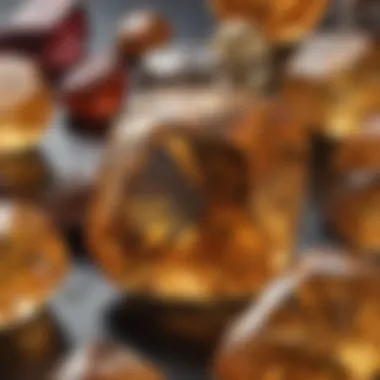
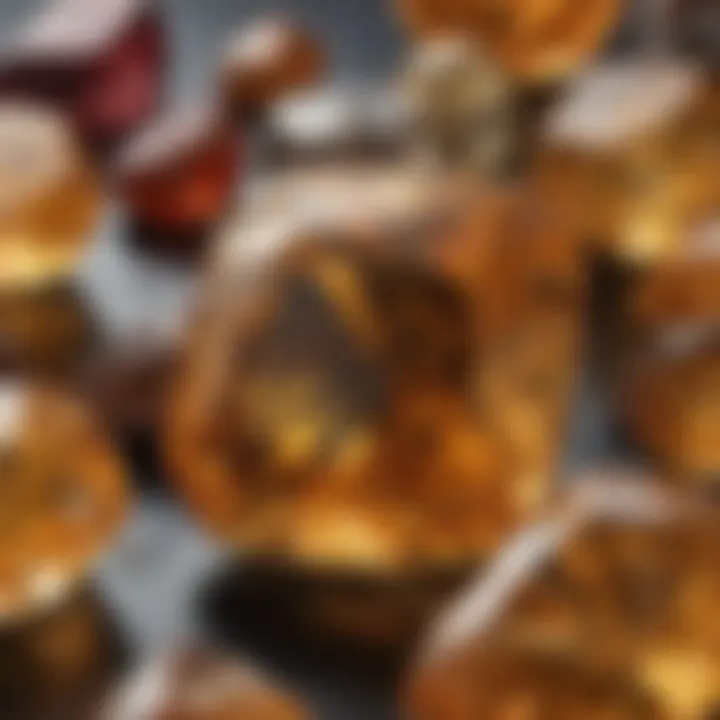
When analyzing the symbolism behind these stones, topaz is often associated with strength and knowledge across various cultures. In ancient Egypt, it was believed to protect against harm while representing the sun’s energy. Citrine, meanwhile, boasts its own rich history, often seen as a stone of prosperity and abundance. Its golden color has long been regarded as a symbol of wealth and good fortune, particularly in Chinese traditions, where it’s considered a lucky stone.
The symbolism surrounding these gems enriches their appeal, offering more than just aesthetics to their owners. Each stone tells a story woven through cultural beliefs and historical significance, adding layers of meaning to their existence.
Usage in Healing Practices
Healing practices involving gemstones have always sparked interest among many people. Topaz is thought to be a stone of reconciliation and joy, believed to promote love, loyalty, and harmony within relationships. It finds itself frequently used in emotional healing and enhancing clarity. Citrine, on the other hand, is beloved for its purported abilities to attract wealth and prosperity. Often dubbed the "merchant's stone," many use it in financial ventures, believing it will bring success.
The distinct healing properties of both stones can cater to the different needs of individuals seeking emotional and spiritual support. By understanding these uses, a buyer can align themselves with a stone that resonates with their personal journey.
Popularity in Contemporary Jewelry
As we look at the contemporary jewelry scene, both topaz and citrine hold significant ground. Topaz’s rich colors and durability make it a coveted choice for statement pieces, often found in rings, necklaces, and earrings. Meanwhile, citrine’s warmth appeals to many looking for versatile pieces that easily transition from day to night.
Both gemstones occupy an essential space within jewelry design, providing options for wearers with varying preferences. By recognizing their appeal, collectors and enthusiasts can appreciate the contribution each stone makes to modern adornments.
Ultimately, comparing topaz and citrine invites a deeper understanding of their unique qualities, guiding individuals toward choices that exemplify their personal taste, beliefs, and preferences.
Choosing Your November Birthstone
Selecting a birthstone, particularly for November, involves much more than just picking a pretty piece of jewelry. This significant stone—whether it be topaz or citrine—carries layers of emotional meaning and personal resonance.
When choosing your November birthstone, it’s crucial to consider what aspects truly align with your personality and lifestyle. Each stone possesses unique characteristics that can complement individual tastes and experiences.
Factors to Consider
Personal Preferences in Color
Color preference is an intrinsic part of any choice related to gemstones. It determines not just how appealing a stone is at first glance but also how it fits into your personal style. Topaz often shines in vibrant shades of yellow, blue, and even clear, making it versatile for various settings. Citrine, on the other hand, captivates with its warm amber tones, providing a more earthy feel.
The shine of a bright citrine can evoke a sunny disposition, while deep blue topaz may resonate with those preferring cooler, soothing hues. So, if you’re an individual drawn to the sun and warmth, citrine might be your go-to choice, whereas lovers of calm and serenity may lean towards the tranquil blue of topaz. The key characteristic here is that color evokes emotions, and selecting a stone that mirrors your mood can enhance your overall connection to it. However, it’s essential to remember that preference is subjective—their unique features open a broad palette, and this could cater to varying affinities.
Budget Considerations
Budget often plays a pivotal role in decision-making when it comes to purchasing gemstones. Whether you are looking for an opulent gift or a personal treat, understanding your budget can guide your options effectively. The price of topaz and citrine can vary widely based on quality and rarity.
Topaz is generally found at a higher price point, especially if it showcases intense colors or unique cuts. Citrine, comparatively, tends to be more budget-friendly, appealing to those looking to maximize value without compromising on beauty. If you opt for a high-quality topaz, you might enjoy its durability and stunning appearance, but it can lighten your wallet considerably. On the flip side, choosing citrine doesn’t necessarily mean settling for less; its affordability does not diminish its charm. Hence, considering your budget wisely can help you find the right stone that offers satisfaction without financial strain.
Authenticity and Quality Checks
When it comes to gems, authenticity and quality are paramount. Everyone wants to ensure that they are investing in genuine stones; fraudulent imitations can lead to disappointment in appearance and durability.
Authentic topaz and citrine typically require a certain level of scrutiny before purchase. You want to look for certificates from reputable gemological labs and check for signs of enhancement, which could affect value. Authenticity checks also educate the buyer about what to expect from their investment. One of the unique features here is that verified stones often carry resell value and lasting beauty. Quality checks also play a role in ensuring that what you buy reflects both personal and intrinsic qualities that are sought after.
Care and Maintenance
Cleaning Techniques
Caring for your gemstones doesn’t have to be complicated, but proper cleaning techniques are essential. Regular upkeep ensures the stones continue to dazzle and don't lose their luster over time. For both topaz and citrine, warm, soapy water and a soft cloth work wonders. Avoid harsh chemicals or ultrasonic cleaners, as they could lead to unwanted damage.
The key characteristic of this approach is that it’s simple and frequently can be done at home. When you take the time to care for your stones, you further establish a lasting connection with them, as they continue shining brightly.
Storage Recommendations
Safe storage is a lesser-known yet crucial aspect of keeping your gemstones in pristine condition. Ideally, separate your topaz and citrine to prevent scratches. Consider using soft pouches or individual compartments in your jewelry box. Avoid keeping them in direct sunlight, which can fade their colors over time.
The advantage of proper storage means your birthstone will maintain its original charisma, providing joy for years to come. Storing these stones carefully allows for longevity and preservation of their natural beauty.
Avoiding Damage to Gemstones
Ultimately, avoiding damage hinges on being aware of how and when to wear your gemstones. For example, it’s wise to remove your jewelry during activities that pose risks, such as exercising or cleaning. Sharp impacts could fracture your stones, especially more delicate variants of topaz.
The key characteristic here is awareness. Being conscious of where and how you wear your stones can significantly extend their life. Simple habits can prevent the need for costly repairs or replacements, allowing you to enjoy your gemstones with peace of mind.
The process of choosing your November birthstone encompasses vast criteria that must be weighed carefully. Each choice reflects personal taste, budget, and dedication to maintaining a sparkling piece of nature’s beauty. By considering these aspects thoroughly, your selection will resonate on meaningful levels.
Ending
The importance of November birthstones cannot be overstated. These gemstones, topaz and citrine, hold a combination of vibrant color and profound significance, intertwining history, culture, and personal meaning. For those celebrating a November birth, the choice of one of these stones transcends mere aesthetics; it becomes a representation of identity and personal attributes.
The Significance of November Birthstones
In understanding the significance of these birthstones, it's essential to consider several key factors:
- Color Variations: Topaz and citrine each offer a medley of colors. Topaz showcases hues like blue, yellow, and even a rare pink, while citrine dazzles with its warm yellows and browns. This range allows individuals to choose a color that resonates with their personality.
- Cultural Heritage: Both gemstones are steeped in rich traditions. For instance, ancient civilizations cherished topaz as a protective stone and a symbol of strength. Citrine, infamous for its sunny disposition, has been linked to prosperity and abundance through the ages.
- Metaphysical Properties: Gemstone enthusiasts often seek these stones for their believed metaphysical benefits. Topaz is associated with healing and clarity, while citrine is celebrated for its supposed ability to enhance mental stimulation and positivity.
The interplay of these aspects not only enhances the allure of November birthstones but also provides collectors and gemstone enthusiasts with a reason to cherish them further. Whether it is for personal wear, gift-giving, or simply as a collectible, the thoughtfulness invested in selecting either topaz or citrine results in a piece of jewelry that becomes an heirloom, laden with significance.
Ultimately, November birthstones symbolize more than their captivating beauty; they encapsulate the stories, beliefs, and dreams of those who wear them. Understanding the depth and meaning behind these stones offers a fulfilling journey for individual and shared histories.



